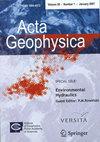Analysis of shear wave velocity estimation using MASW on sloping grounds
Abstract
Applying the multichannel analysis of surface waves (MASW) test in sloping ground conditions is of significant interest in the geotechnical investigation when estimating a subsurface shear wave velocity \(({V}_{s})\) profile. The soil stratification in sloping ground violates the assumption of the horizontal soil layer in the vertically heterogeneous medium and results in misinterpretation of the \({V}_{s}\) profile in a MASW test. One of the major challenges in this context is to identify an effective frequency range that can be used to invert the dispersion curves. This study presents a methodological framework to address the issues mentioned above. The analysis involves finite element (FE) simulations for a homogeneous sloping soil model and a six-layer sloping soil model, along with the field test validation. The wavefield was recorded for the duration of 0.3 s with a sampling frequency of 4000 Hz. Spectral characteristics of the recorded wavefield, such as attenuation of Fourier amplitudes as a function of offset distance and amplification/de-amplification of the wave amplitude (through different velocity layers), were examined. Moreover, the variation of unwrapped phases and cross power spectrum (CPS) between each pair of receivers was analyzed to identify the effective frequency range of dispersion curves. Finally, the proposed approach was successfully validated using a comparison of the \({V}_{s}\) profiles obtained from field MASW and downhole seismic tests.


 求助内容:
求助内容: 应助结果提醒方式:
应助结果提醒方式:


